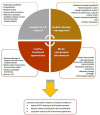Guidelines for treating child and adolescent obesity: A systematic review
- PMID: 36313105
- PMCID: PMC9597370
- DOI: 10.3389/fnut.2022.902865
Guidelines for treating child and adolescent obesity: A systematic review
Abstract
Obesity is a chronic disease that compromises the physical and mental health of an increasing proportion of children globally. In high-income countries, prevalence of paediatric obesity is increasing faster in those from marginalised populations such as low-income households, suggesting the disease as one that is largely systemic. Appropriate treatment should be prioritised in these settings to prevent the development of complications and co-morbidities and manage those that already exist. An array of clinical practice guidelines are available for managing overweight and obesity in children and adolescents, but no systematic review has yet compared their quality or synthesised their recommendations. We aimed to narratively review clinical practice guidelines published in English for treating child and adolescent obesity, to identify the highest quality guidelines, and assess similarities, conflicts, and gaps in recommendations. We systematically searched academic databases and grey literature for guidelines published. We used the AGREE II tool to assess the quality, and identified nine high quality guidelines for inclusion in a narrative review of recommendations. Guidelines predominantly recommended the delivery of multi-component behaviour-change interventions aimed at improving nutrition and physical activity. Treatment outcomes were generally focussed on weight, with less emphasis on managing complications or improving quality-of-life. There was no evidence-based consensus on the best mode of delivery, setting, or treatment format. The guidelines rarely included recommendations for addressing the practical or social barriers to behaviour change, such as cooking skills or supervised physical activity. There is insufficient evidence to evaluate pharmaceutical and surgical interventions in children, and these were generally not recommended. It should be noted that this review addressed documents published in English only, and therefore the included guidelines were applicable predominantly to high-resource settings.
Keywords: bariatric; childhood obesity treatment; clinical practice guidelines; medical nutrition therapy; obesity management; paediatric obesity; physical function; weight management.
Copyright © 2022 Tully, Arthurs, Wyse, Browne, Case, McCrea, O’Connell, O’Gorman, Smith, Walsh, Ward and O’Malley.
Conflict of interest statement
The authors declare that the research was conducted in the absence of any commercial or financial relationships that could be construed as a potential conflict of interest.
Figures
References
-
- NCD Risk Factor Collaboration (NCD-RisC). Worldwide trends in body-mass index, underweight, overweight, and obesity from 1975 to 2016: a pooled analysis of 2416 population-based measurement studies in 128.9 million children, adolescents, and adults. Lancet. (2017) 390:2627–42. 10.1016/S0140-6736(17)32129-3 - DOI - PMC - PubMed
-
- Bel-Serrat S, Heinen MM, Murrin CM, Daly L, Mehegan J, Concannon M, et al. The Childhood Obesity Surveillance Initiative (COSI) in the Republic of Ireland: Findings from 2015/2016. Dublin: Health Service Executive; (2017).
Publication types
LinkOut - more resources
Full Text Sources



